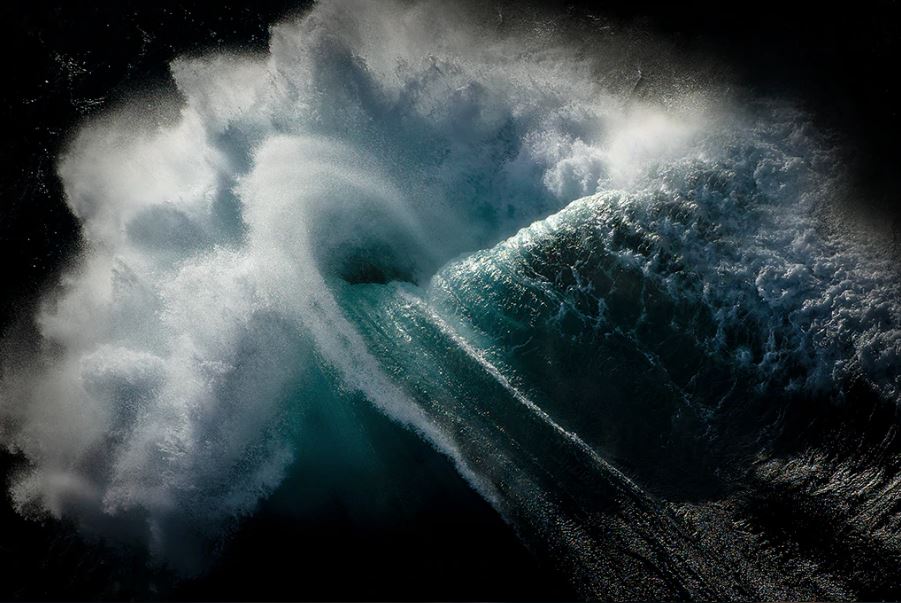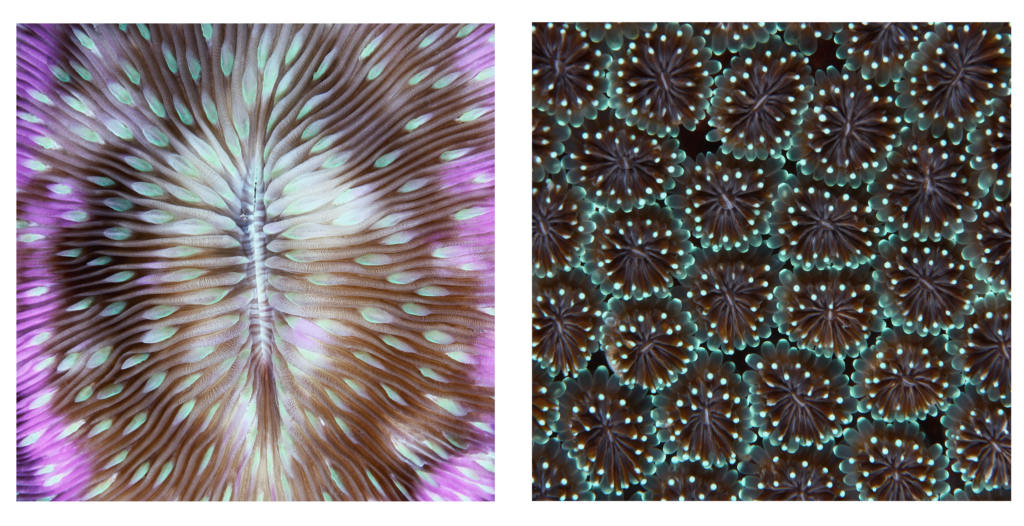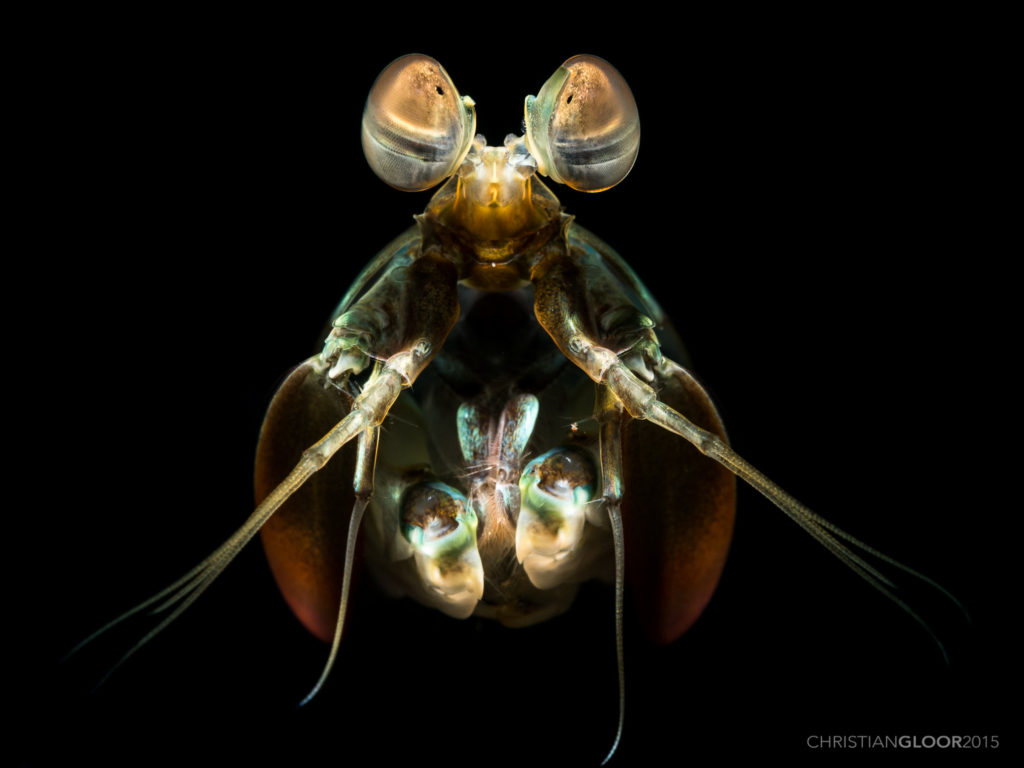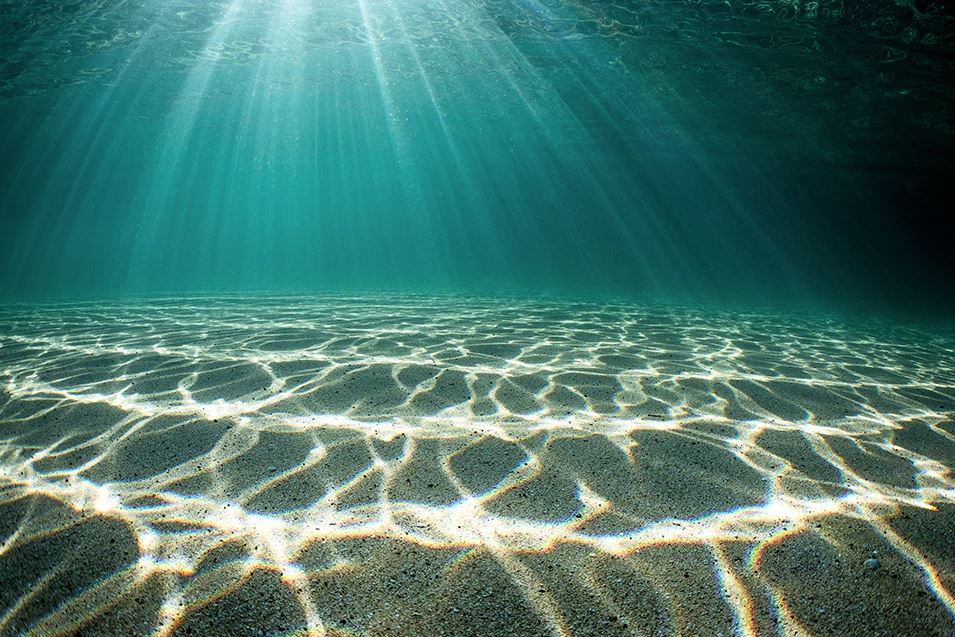Photo by Ray Collins
Futuristic secrets from a billion-year-old
The most powerful force on earth is behind every other breath you take, and with the same ease it can take it away. The ocean is both killer and healer, vulnerable and formidable, and permanently uncontrollable. What has figured out how to survive here is a living blueprint of what works and what never had a chance. Now, the most unexpected ocean creatures may inform what our futures look like.
What does it mean when a shrimp shapes the future of aircraft, dolphins predict tsunamis, and invisible organisms help solve the plastic crisis? It means in a world dominated by market-driven solutions and rushed progress, it’s our billion-year-old planet that’s shaping the future of technology and commanding the attention of obsessed innovators, conservationists, and hardcore business folks. Just by being.
Makes you think: Who are the real masters of technology?
Below are six ways the ocean is getting us closer to what the world needs while giving us a refreshing spray of humility in honor of World Oceans Week at The Explorers Club.
What if we could mimic a coral’s ability to build a reef in order to clean up one of the dirtiest, hardest-to-green (and growing) industries?
(STUNNING!) mushroom coral and Galaxea fascicularis photographs by Silvie De Burie
1. How coral skeletons help build future cities
Organism: Coral (Anthozoa)
Time on Earth: 240 million years
Problem solved: Mimic coral’s ability to build reefs to clean up one of the dirtiest, hardest-to-green (and growing) industries
Behind the science: Stanford University, Blue Planet Systems
Potential applications: Improved concrete materials that do the job, emit less, and sequester CO2
Source: Scalable Carbon Sequestration Inspired by the Common Stony Coral (AskNature)
UN Sustainable Goal Addressed: Goal 12
Let’s nerd out:
What do coral reefs—SO MAJESTIC, SOME CAN BE SEEN FROM OUTER SPACE—have to do with the future of our built world? Hopefully a lot. Especially since the equivalent of a new NYC will be added to the planet every month between now and 2060. The reason this is a huge deal is that cement, steel, and other building materials are a massive source of harmful climate-warming carbon emissions. Concrete isn’t going anywhere. We need to make it better. Innovators are looking to coral for help.
To understand this better, let’s take a quick dip into Corals 101: Those kingdoms of explosive color and texture pulsing with life are actually a collection of tiny animals called polyps. Polyps are soft and vulnerable. Their superpower is their incredible ability to grow a hard limestone “skeleton” which connects to other polyps’ tiny skeletons. This interconnected base creates the infrastructure of a coral reef so spectacularly impressive that some, like Australia’s Great Barrier Reef, are hanging on at 20,000 years old.
Now, look around. We challenge you to find something not made of concrete. Floors, sidewalks, roads, bridges, buildings, dams, ramps. Even the 2,000-year-old Pantheon in Rome symbolizes not just concrete’s omnipresence, but its staying power. It’s the most consumed stuff on the planet after water, and this beast of an industry is behind roughly 8% of global carbon dioxide emissions. That’s partly because the amounts of heat required to turn cement (the liquid stuff) into concrete (what you walk on) are massive and unsurprisingly unsustainable.
Now coral-inspired concrete production led by a company called Blue Planet attempts to change that, and looks something like this: 1) take waste CO2 gas from power plants, 2) dissolve it into seawater, and 3) allow that process to create a solid after it mixes with calcium in the seawater. This is significant, because they not only mimic a coral reef’s ability to create limestone without extraordinary amounts of CO2, but every tonne of their aggregate permanently mineralizes 440 kg of CO2–sequestering it in building materials around us where it’s safe and permanently keeping it out of the air we breathe.
Imagine creating future cities where air pollution is locked safely in the built world around us. You may have already experienced this at Terminal 1 at San Francisco International Airport where Blue Planet Systems has incorporated their concrete. And get ready for more–the company is ready to expand to gigaton scales. We are ready for the other coral copycats!
If the mantis shrimp was in the Olympics, they’d win gold for their ability to pack a punch. Now, innovators are mimicking their superpower to inspire tougher, lighter, cheaper, greener composite materials. | Photography by Christian Gloor
2. What a shrimp teaches us about mastering materials from helmets to turbines
Organism: Mantis Shrimp (Stomatopoda)
Time on Earth: 400 million years
Problem solved: Mimic what’s behind a shrimp’s powerful punch to inspire tougher, lighter, cheaper, greener composite materials
Behind the science: U of Cambridge, UC Riverside, U of Bath, U of Maryland, U of South Carolina, U of Vermont, U of Texas – Austin, Helicoid Industries
Potential applications: Wind blades, protective sports equipment, transportation, aerospace
Source: Strong, Durable Composite Technology Inspired by the Mantis Shrimp (AskNature)
UN Sustainable Goal Addressed: Goals 9, 11, 12
Let’s nerd out:
If the mantis shrimp was in the Olympics, they’d win gold for their ability to pack a punch. Their signature clubs beat out a .22-caliber bullet at 60 MPH—underwater!—and are so powerful that the water in their path boils. It’s for this reason they are too dangerous to keep in captivity. That puny shrimp’s punch can break aquarium glass. Now this shrimp’s punch is informing the future of composite materials from designing safer motorcycle helmets to more advanced wind blades and airplanes.
Their unusual strength is thanks to the unique structure of their clubs known as “helicoids,” essentially a twisted stacked structure (think about a slinky or a spiral staircase) that beats out other biostructures in strength and toughness. Top innovators have reverse-engineered this spiral structure for reasons including 1) it’s unique ability to absorb shock and disperse energy efficiently (better ability to handle impact, better damage tolerance), and 2) the shape means less material is necessary than a solid (lighter weight and less raw material mean cost savings without losing strength).
Bottomline: the mantis shrimp is punching a hole in the dated way we’ve thought about materials, and gives us a solution to create materials that are tougher, lighter, cheaper, stronger. This technology is not a future concept; it’s proven and available today.
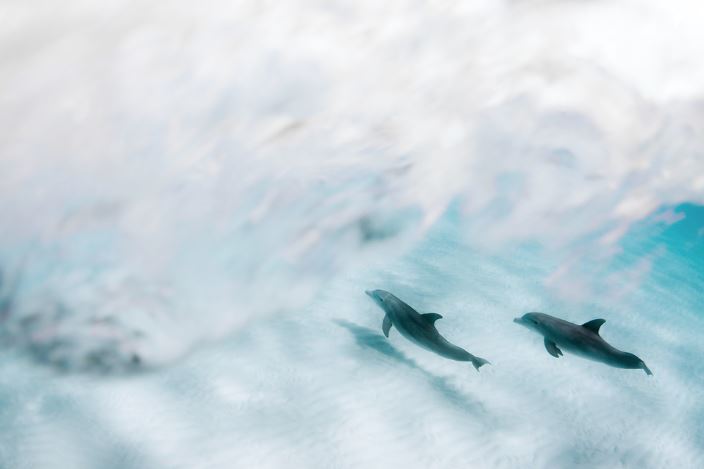
A dolphin’s unique ability to communicate across long distances under water, even in chaotic ocean conditions, has attracted scientists and innovators and may predict the next natural disaster | Photograph by Shane Gross
3. How dolphins can help predict the next tsunami
Organism: Dolphin (Delphinus)
Time on Earth: 50 million years
Problem solved: Mimic dolphin sound patterns and range of frequency for reliable underwater communication
Behind the science: EvoLogics S2C Technology
Potential applications: Natural disaster detection; wireless acoustic networks; advanced subsea monitoring and production systems; robot operation
Source: Underwater Acoustic Communication Inspired by Dolphins (AskNature) + National Library of Medicine
UN Sustainable Goal Addressed: Goal 15
Let’s nerd out:
There are extraordinary examples of dolphins saving lives: rescuing people out at sea, alerting lifeguards about a stranded swimmer, and even herding swimmers away from an attentive shark. Now they are helping save lives without even being nearby.
You’d think we’d have their signature chattiness–squeaking, clicking, whistling–to thank. Well, sort of. While it plays a key role in their unique ability to deepen community, companionship, connection (each dolphin’s sound is so unique their pod can identify a dolphin’s “voice” decades after hearing it), it’s their ability to get their messages across long distances underwater, at times in brutally hostile conditions, that has attracted scientists and innovators.
If we zoom in a bit further, they are looking more specifically at the physics of dolphin communication and the range of their high and low frequency sound bandwidth for advanced and reliable underwater data transmission. Because, while sound travels through water (5x faster than air), a zig zagging mess of colliding signals can result in a failed communication. A dolphin’s unique advantage is they change the pitch of their whistles, and this range of frequencies beats water’s tendency to mix up the signals.
Generally one of the messages will go through, even from long distances in the most hellishly rough ocean conditions. This helps innovators predict tsunamis and other natural disasters before they get to us. This technology is currently being used in the Indian Ocean to sound the alarm on natural disasters before they wreak havoc on local communities.

Oysters are the inspiration behind restoring key marine habitats and coastal community resilience | Photograph by GROW Oyster Reef
4. How an oyster can help save your life
Organism: Oyster (Ostreidae)
Time on Earth: 15 million years
Problem solved: Mimic an oyster’s surface structure to create underwater infrastructure that boosts biodiversity and restores coastal marine habitat
Behind the science: GROW Oyster Reefs LLC, MIT, University of Florida, Schmidt Marine Technology Partners, Chesapeake Oyster Alliance, The Nature Conservancy
Potential applications: Underwater infrastructure that can secure coastlines, restore biodiversity, enhance coastal resilience
Source: Concrete Mix Inspired by Oysters (AskNature)
UN Sustainable Goal Addressed: Goals 9, 11, 14
Let’s nerd out:
Their blood is transparent. They can change their gender. One of these 350-million-year-old keystone species can filter 50 gallons of water in a single day. Whether you love ‘em, hate ‘em, crave ‘em, gag on them, or pay them no attention, oysters have always been a big deal. And now they are the inspiration behind restoring key marine habitats and coastal community resilience.
Here’s why:
An oyster shell’s nooks and crannies have a purpose. They are vital to marine life as their unevenness creates tiny cubbies for life to cling onto, hide in, and create their home. Some baby animals are only able to find protection in the safe haven of oyster reef habitat. They change the way ocean life lives, where it can live, and even the flow of the ocean. They are one of the ocean’s top architects.
This little marine bivalve also protects our coasts (flooding, erosion, vicious storms) in a similar way to how coral reefs protect islands. The jagged ripple that is created on the ocean floor by oyster reefs is a buffer for intense waves before they hit shore.
At a time when our maps are being redrawn as coastlines crumble into the sea (and islands go underwater as the sea keeps swelling), this is significant.
That’s why GROW Oyster Reefs (a 2021 Ray of Hope Prize finalist!) chose to mimic oyster shells and oyster reef systems to create a series of products. Their proprietary concrete mixture draws in marine life such as baby oysters (called spat–adorable) and mussels that work together to enhance coastal defense and an invaluable seawall that slows down untamable waves.
Other reasons we love them:
While they seemingly passively cling onto that rock, post, boat, dock, or shoreline, they are creating “livable” water by constantly sucking in water and purifying it. This process prevents those depressing and dangerous “dead zones” that are the result of too much nitrogen. This water purification process also plays a role in protecting our coasts. This is because clean water means marsh grasses can survive and anchor their roots. And that means fierce storms have less of a chance to dismantle and wreak havoc on our increasingly vulnerable shores.
A real-deal wonder material that helps tackle the plastic and climate crisis now exists thanks to an invisible ocean organism. | Photography by Warren Keelan
5. Could invisible organisms create a new breed of plastic that improves the world?
Organism: Ocean microorganisms
Time on Earth: > 100 million years
Problem solved: Harness ocean microorganisms to create a regenerative plastic that can decompose like a leaf, store air pollution, and outperform oil-based plastics
Potential applications: New materials
Behind the science: Newlight Technologies
Source: Plastic Alternative Biomaterial Inspired by Ocean Microorganisms (AskNature)
UN Sustainable Goal Addressed: Goals 11, 12, 13
Let’s nerd out:
We can hate plastic all we want, but the fact is, most of us are addicted to it. It’s annoyingly convenient and everywhere: from your dog’s pick-up bag and the polyester in your gym clothes to what’s inside your mattress. What was once dubbed a wonder material has caused a global emergency and nation leaders and global brands are starting to respond: single-use plastic bags are banned from Rwanda to Thailand. McDonalds, General Motors, and Amazon are next.
A real-deal wonder material exists thanks to an invisible ocean organism.
Right now, an invisible ocean microorganism is creating a material that 1) helps solve the plastic crisis and 2) helps reverse climate change. This biomaterial functions like plastic and can disintegrate on land and in the water (just like leaves do), is made without oil (traditional plastic’s feedstock), and could lock in air pollution and remove carbon as it is produced.
Here’s how it works: There are tiny organisms in the ocean that gobble up greenhouse gas for lunch every day. This process naturally creates a material called PHB. While this process has occurred for millions of years in the ocean, it has never been done on land. A company called Newlight recreated the microogranism’s process on land in large steel tanks. The organisms fed on methane (a greenhouse gas), carbon dioxide (a greenhouse gas), saltwater and air, and created a natural material known as PHB. The material created, which Newlight calls AirCarbon, has all the qualities we want of a plastic without the ones that are wreaking havoc in and around us (microplastics are now not only found in water but also human blood).
Looking into our oceans or even our own blood is proof that the material world we’ve created no longer works. This innovation symbolizes a meaningful change in how we can approach new materials. By looking to nature and seeing a way to repurpose the throwaway carbon in our atmosphere, we turn an environmental villain into a valuable resource. And we have a new collection of biodegradable, biocompatible, and durable materials for everything from cutlery to office chairs. Our modern world craves a fix to our plastic problem, and thanks to an unforgettable ocean organism we’re on our way.
Note that this approach is not straightforward biomimicry, but a bioinspired solution that emulates a process found in nature while using natural organisms in the process (bioutilization).
Manta rays dance through the water, and now, their graceful ways are literally taking to the skies.
Image: Arturo de Frias Marques | Wikimedia Commons / CC BY SA – Creative Commons Attribution + ShareAlike
6. How manta rays inspire flying machines
Organism: Manta ray (Manta)
Time on Earth: 5-10 million years
Problem Solved: Transport that’s faster, quieter and goes further
Behind the science: NASA; Boeing; Lilium Air Mobility; Office of Naval Research through its Multidisciplinary University Research Initiative Program, the National Science Foundation and the David and Lucile Packard Foundation
Potential applications: Aerospace
Source: PLOS ONE journal and MDPI
UN Sustainable Goal Addressed: Goal 14
Let’s nerd out:
We have historically looked up for flight inspiration: Leonardo da Vinci’s flying machine sketches were inspired by birds and bats, pigeons inspired the Wright Brothers’ first successful airplane, and the military’s mini drones emulate dragonflies. But there’s a new kid on the runway: manta rays.
Manta rays dance through the water, and they continue capturing our attention in new ways as designers explore bio-inspired aircraft that could go faster, quieter, and more efficiently. With more than 50,000 planes expected to be flying in the next two decades, skyrocketing efficiency will be essential to our decarbonization goals.
The sleek, aerodynamic design has caught the attention of NASA engineers and Boeing who looked at the manta ray wing when designing various versions of the aircraft known as X-48. The single body unit has an innovative blended wing body structure, where the engine of the aircraft sits on the plane wings versus under them and a lack of a conventional tail. This aircraft has demonstrated NASA’s goals of reduced fuel, emissions and noise, though one of the bigger challenges is the lack of a conventional tail has made it more challenging to stabilize and control.
And this year, Lilium has people talking about their Lilium Jet, an all-electric air taxi which mimics manta rays’ structure: minimal, elegant, wings, no tail, no rudder, and only one moving part in each engine. The winner of the prestigious Red Dot Award, this five-seater aircraft takes off and lands vertically and could be another path towards decarbonization as early as 2025.
Biomimicry: Where overlooked masterpieces get the attention they deserve
These examples illustrate that what we may dismiss as having zero life and zero value–like that crusty old oyster shell–give us clues about the next breakthrough. Ancient life and advanced technology are not mutually exclusive. Oceans are living proof.
When a shrimp’s punch or coral skeletons are packed with key knowledge on how to innovate and protect what matters–and we have the humility to pay attention–we, and the future we are creating, are better.
 Katie Losey works at the intersection of business and conservation. She believes powerful storytelling that speaks to both heart and head can be a persuasive tool to drive action and change minds. She is a director at Fragile Earth, a company focused on catalyzing a new energy era to benefit all life on Earth. Previously Katie led marketing at a travel company connecting others with wild places to help protect and champion them, landing her with orangutans in Borneo’s rainforest canopy to humpbacks while kayaking in Antarctica—mind-expanding experiences to explore the genius of biomimicry! She has been a member of The Explorers Club since 2015 and was part of their first flag expedition to Cuba documenting unexplored coral reefs. Katie lives in NYC with her rescue dog Nelle. Connect with Katie on Instagram and LinkedIn.
Katie Losey works at the intersection of business and conservation. She believes powerful storytelling that speaks to both heart and head can be a persuasive tool to drive action and change minds. She is a director at Fragile Earth, a company focused on catalyzing a new energy era to benefit all life on Earth. Previously Katie led marketing at a travel company connecting others with wild places to help protect and champion them, landing her with orangutans in Borneo’s rainforest canopy to humpbacks while kayaking in Antarctica—mind-expanding experiences to explore the genius of biomimicry! She has been a member of The Explorers Club since 2015 and was part of their first flag expedition to Cuba documenting unexplored coral reefs. Katie lives in NYC with her rescue dog Nelle. Connect with Katie on Instagram and LinkedIn.

